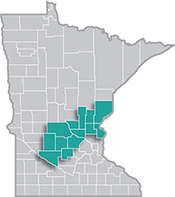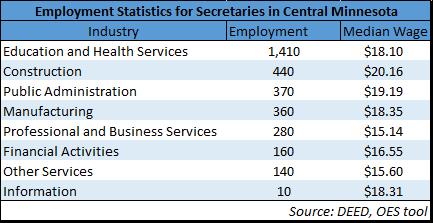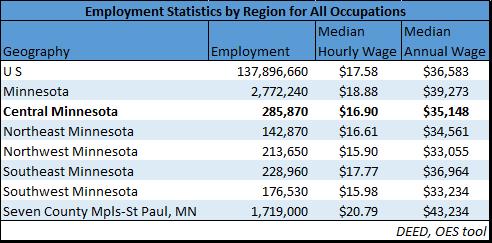 Central Minnesota is a manufacturing stronghold, with several global manufacturing firms operating there.
Central Minnesota is a manufacturing stronghold, with several global manufacturing firms operating there.
The region is especially well known for its expertise in food processing, printing, furniture manufacturing, appliances, machinery and heavy equipment manufacturing.
View our latest blogs on CareerForce. Want the freshest data delivered by email? Subscribe to our regional newsletters.
5/2/2016 10:09:32 AM
Luke Greiner
Just like a jump in the lake in May is refreshing, DEED’s Occupational Employment Statistics (OES) got a breath of fresh data this month and is now current through the first quarter of 2016! Known in the past as the Minnesota Salary Survey, the OES program has been the principle source of wage data for over 30 years, providing employment estimates and wages for selected occupations in the state and local regions.
The OES data covers roughly 800 identified occupations, providing a range of wages from the 10th to the 90th percentile, including the mean and median; as well as wage and employment estimates for the same occupation across different industries.
One of the most interesting aspects of the wage data are the variations found within different industries. For instance, the table below illustrates employment and wages for secretaries working in different industries within Central Minnesota. With 40 percent of all secretary jobs in Central Minnesota, the largest amount of secretary jobs is found in the education and health services industry with 1,410 jobs. However, the highest median wages are found in the construction industry at $20.16 per hour.

Both employment and wages work together to describe opportunities for job seekers. High wages combined with many jobs is a great avenue for success. In other cases, very high wages with low employment might not offer the same amount of opportunity and job openings could be scarce, but the wage premium could be worth the risk.
For businesses, using OES data is possibly even more important. Business both provide the data and become core consumers of the results. A business in the professional and business services industry can size up the competition for secretaries (using the previous data example) to develop a strategy or policy for recruitment and retention. They may need to raise wages to compete for secretaries.
DEED provides OES data at a regional level so comparisons can be made between different geographic areas of the state. As of the first quarter of this year the median hourly wage across Minnesota was $18.88 per hour, while the median wage in Central Minnesota was $16.90. The median wage for all occupations in Central Minnesota is about 12 percent lower than the state, but 23 percent less than its largest competing labor market, the Twin Cities (see Table 2).

To view wage and employment data, go to https://apps.deed.state.mn.us/lmi/oes/OesSelect.aspx. Simply select your desired geography (*hint, use the map if you’re unfamiliar with the defined regions) and then enter a job title and click “Find”; or select general occupations from the occupational list or view more detailed occupations within a category to fine tune your selection.
As shown below, results are displayed in a simple table with percentile wage breakdowns for both your selected region, but also Minnesota, and the United States. The occupational detail page also contains the wage and employment estimates by industry and for other regions in the state.

Now that you know, go start exploring DEED’s Occupational Employment Statistics!
Contact Luke Greiner at 320-308-5378.